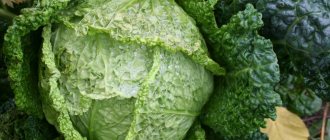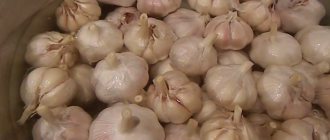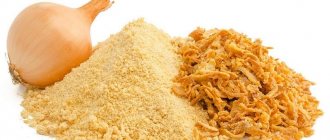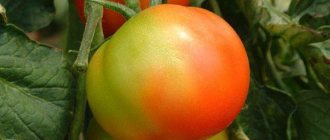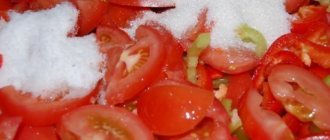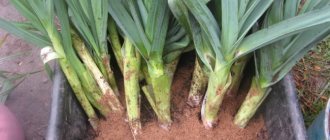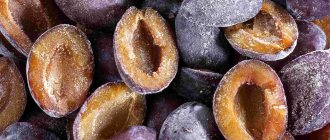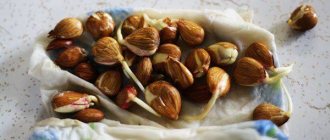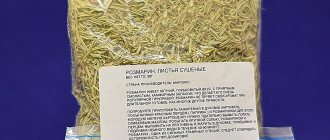Dried garlic is useful not only in the off-season. Storing heads at home is not always convenient; this requires space and a certain microclimate.
On average, 2.5 kg of fresh garlic can be turned into 0.5 kg of dried product, which will easily retain its properties, and store it in a jar on the kitchen cabinet shelf. To do this, you need to work a little and fulfill certain requirements for drying the product. But the result of the work will please you throughout the year.
What are the benefits of dried garlic?
Garlic is not only an aromatic seasoning, without which many dishes cannot fully reveal their taste, but also a real storehouse of useful minerals and vitamins: K, Mg, Z, Se, Cu, Mg, Fe, Co, P, Na, B, C, E, PP, choline. Eating dried garlic, like fresh garlic, has a beneficial effect on health, as it contains phytoncide - a natural antibiotic in the fight against fungal diseases and viral infections.
Regular consumption of garlic in moderate doses improves immunity, lowers cholesterol, improves heart function, reduces the risk of strokes and heart attacks, combats helminthic infestations, and is used in the treatment of diseases and the prevention of impotence in men. Garlic is not used for diseases of the digestive system.
If dried properly, the vegetable will retain its beneficial properties. In order not to cause harm, you must remember that dried garlic is a concentrated product, and this fact must be taken into account when consuming.
Oven drying
Dry not only in the fresh air
In the modern world, an oven is used to dry crops in an apartment. Before drying garlic, it should be completely cleaned of excess leaves and roots, and then rinsed thoroughly under running water.
The cloves are cut into plates a couple of millimeters thick. The slices are laid out on a baking sheet, having previously covered it with parchment or foil. The plates are stacked in one row. The oven temperature should not exceed 50 degrees, otherwise the slices may burn and acquire an unpleasant brown tint. Once dried, the garlic can be ground into granules and stored as a powder. A similar method is used in industrial production, since storing the onion in powder form is convenient and practical.
What conditions must be met for proper drying?
Dig in dry weather. It is clear that the less moisture a vegetable contains, the easier it is to dry it. That is why garlic needs to be harvested in dry weather, so that there is no rain or watering for several days before harvesting.
It is recommended that cleaning be done around noon or in the afternoon. It is also not recommended to wash the vegetable, as it will take a long time to dry and may become moldy.
Collect ripened garlic. By the time of harvesting, the garlic should be fully ripe, as evidenced by yellowed or fallen foliage. Unripe bulbs are not dense, loose, and dry poorly. Overripe ones - when dug up, they fall apart into cloves, which lose their covering scales and are smeared with earth, which complicates further processing, since the cloves cannot be washed.
Head sorting. For drying, dry, clean, healthy bulbs are selected, without signs of disease, damage, or mold. The heads must be well formed. If the outer scales are not damaged, then the teeth inside will be clean, without soil.
Disassemble into teeth. If the method of drying peeled garlic is chosen for work, then the heads are first freed from the husks covering them, and the cloves are carefully inspected for damage, dents, and stains. The root neck of the cloves is cut off.
Cut. For drying, garlic must be cut in such a way that no juice is squeezed out of it. That is why the graters and food processors available in the household are not suitable for slicing. It is best to arm yourself with a thin, sharp knife. Cut the cloves for drying:
- in an electric dryer - across with thin plates;
- in natural conditions - in long slices, cutting the cloves in half.
It is desirable that these plates are no thicker than 5 mm. They are laid out for drying with the cut side up, so the juice will not drain.
Attention! To prevent burns to your hands, you must use rubber gloves. The room is ventilated, since the high concentration of garlic vapor quickly irritates the mucous membrane of the nose and eyes.
Preparation rules
Before drying spices at home, you need to prepare the raw materials. The heads need to be cleared of soil and husks and left to dry for 5-10 days in a dry, cool room. During preparation the following conditions must be met:
- Preservation of leaves after digging. This will help the garlic retain as many nutrients as possible after drying.
- Lack of moisture. Do not wash the vegetable after harvesting, as this may lead to rotting. Garlic can only be peeled mechanically.
- Accuracy. There is no need to shake off the soil from the garlic by tapping it on a hard surface. Impact damage will shorten the head's shelf life.
After the garlic dries, you need to trim off the stems and leaves. After this, the vegetable is divided into individual cloves. They are crushed in one of the following ways:
- On a coarse grater. Not the best way, since friction releases a lot of juice, which will complicate the drying process. In addition, this grinding process removes many aromatic substances.
- On a food processor. This method is simpler than the previous one, but completely retains the same disadvantages.
- Use a knife to cut into thin slices. This is the best grinding method for oven drying and electric drying.
- Cut into two halves with a knife. This grinding method is suitable for drying in fresh air.
Garlic must be checked for rot and damage. If there are small dark spots on the cloves, they need to be trimmed.
Important! If a green sprout has formed in the garlic, it must be removed so that the seasoning does not turn out bitter.
How to dry garlic - possible methods at home
In the sun
Immediately after digging up the garlic, it is laid out on a ridge so that the tops and roots dry. In the field, the vegetable can be dried in dry weather with partly cloudy weather.
The plant cannot be dried under the scorching rays of the sun, otherwise the teeth will get burned. In damp, rainy weather, garlic should not be left in the field either.
It is transferred to a dry, well-ventilated room or under a canopy and laid out on mesh or lattice bases. After the tops have dried, they are cut off, leaving low stubs (3-5 cm), and the roots are trimmed to the root collar (0.3 cm). During drying, the scales will tightly envelop the bulb and ripen.
In conjunction
Garlic is often braided or tied into small bunches and hung on the walls or attic in a dry, cool, ventilated room. In this state it can be stored for fresh use or further deep drying.
Without destroying the bulbs
One of the methods for producing dried garlic for long-term storage. The hard husks are completely removed from the heads, without disassembling the onion into cloves. Subsequently, the cloves are cut into pieces, no thicker than 5 mm, placed on baking sheets covered with parchment and sent to the oven or oven. Dry at a temperature of 50°C, stirring and ventilating. Dried garlic is winnowed to remove any remaining husks.
Peeled garlic
With this method, the cloves are completely freed from scales, cut into thin slices, laid out on parchment and sent to a dryer or oven.
Important! When drying, do not allow condensation to accumulate, so as not to steam the vegetable, but to dry it.
To do this, the door of the dryer or oven is periodically opened, and the raw materials are turned over or mixed.
When to collect spices and how to do it correctly?
It is very important to choose the right time to harvest. To do this, you need to monitor the leaves of the plant. Once most of them have turned yellow, the garlic is ready to harvest. There is another way to determine the ripeness of a vegetable. To do this, leave one arrow on the garden bed. The garlic will be considered ripe when the seeds appear.
Garlic is harvested only when the soil is completely dry. You need to dig it out very carefully. First, the bulb is carefully dug up, then pulled out by the base of the stem.
Reference! Varieties planted for winter usually ripen in August. But spring varieties will be ready for harvest somewhere in mid-autumn.
Not all garlic is suitable for making dry seasoning. Many varieties are not suitable for this, as they lose their taste when moisture decreases. Common varieties used to make dried garlic are silver white and creole . The following varieties are also suitable:
- Starobelsky white;
- southern violet;
- Kirovograd;
- Bronnitsky;
- Kalininsky
Garlic cloves must be healthy and free from pests and rot.
How to properly dry garlic
In room
Vegetables can be dried naturally only in a well-ventilated, dry room, so that the sun does not fall on it. The cloves, cut in half, are laid out on a flat surface with the cut side up, periodically inspected and moved. Even under good conditions and dry weather, the drying process takes at least 10-15 days and there is a risk that the material will become moldy.
In the oven
Garlic cut into thin slices is placed on a baking sheet covered with baking paper. The temperature in the oven should be no more than 50-60°C. Every 30 minutes, remove the baking sheet from the oven, turn the plates over, cool and put them back in the oven. To allow air to enter, do not close the door tightly. The drying process will take from 3 to 8 hours, depending on the condition of the source material.
In an electric dryer
For this method, the onions are cut into thin transverse slices and laid out in one layer on a wire rack. You can use a special mesh spacer to prevent small petals from falling into the grid. The optimal temperature for drying is 50°C.
At temperatures above 60°C, garlic will begin to lose its beneficial substances and aromatic properties.
Garlic powder
How to dry garlic at home? In the oven, the drying process occurs much more quickly: up to 6 hours. The peeled cloves are cut into thin slices and placed on a baking sheet covered with parchment. The temperature in the oven is set to 50 degrees. Such a low temperature regime makes it possible to smoothly remove all moisture and preserve the valuable properties of the product.
After 3 hours, you should check the readiness of the teeth and stir them if necessary. When the slices begin to crisp and break, this is a sign that they are ready.
It is recommended to open the oven door from time to time to allow air flow inside. If the oven has a convection mode, then you do not have to open the oven.
When the drying process is over, the cooled teeth are crushed in a coffee grinder or blender (it will be ground), or pounded in a mortar. The crushed garlic powder is stored in the refrigerator.
Dried garlic cloves are crushed in a coffee grinder or blender, thus obtaining a homogeneous powder. If the plates do not crumble well, you need to dry them further. Based on the powder, an amazing seasoning is made - garlic salt, which gives a special piquancy to the dish. The ratio is 1:3, one part garlic powder is mixed with three parts sea salt.
Try to use this aromatic seasoning in the first winter, otherwise the beneficial and aromatic properties will be lost in the future.
Advice! Garlic powder should be stored in hermetically sealed containers in a dry place. The seasoning can be stored for 1-2 months without losing its properties, then the aroma and taste begin to be lost.
Well-dried and cooled garlic slices are ground in a coffee grinder or blender until powdered. Then sift through a sieve so that the resulting powder is homogeneous. You can chop the garlic to coarse crumbs, then the prepared topping will taste good in the dish.
If the garlic cloves do not chop well, it means they are not dried enough. You need to additionally dry them in the oven, cool again and grind.
Store garlic powder in glass, well-closed jars. Shelf life is about a year.
How and where to dry garlic to obtain powder from it? Garlic slices dried using the methods described above can be crushed either in a blender or in a coffee grinder until a powder is achieved. The resulting mass is sifted through a sieve to achieve a homogeneous state. The aroma of garlic, crushed to coarse crumbs, is better felt in dishes.
After all of the above methods of drying garlic, the finished products are placed in sealed jars, paper bags and boxes and stored in a cool, dry and dark room for a year.
In what form should I use it: powder or seasoning?
- Powder.
To produce the powder, garlic, well dried using one of the listed methods, is used. It should break when bent. Grind the records using a coffee grinder or blender. The grind size can be chosen as desired. To isolate a larger fraction, the grinding can be sifted through a sieve.
- Seasoning.
For seasoning, the bulbs can be dried alone or with other ingredients. In this case, dense varieties of tomatoes, carrots, and apples are used. Everything is cut into thin rings or half rings. As it dries out, add herbs (basil, dill) to the free spaces.
The video shows a recipe for dried garlic powder in an electric dryer.
Benefits and harms
Before looking at the various methods for making seasoning at home, it is necessary to know how dried garlic affects the body. The popular seasoning has both positive and negative sides. Before you begin preparing the product and consuming it, be sure to read the information below.
Let's start with the positive impact.
Digestion
Dried garlic has a beneficial effect on digestive processes. This useful characteristic is important for everyone, without exception, regardless of the state of the gastrointestinal tract. An aromatic plant added to dishes with a high fat content helps to absorb and digest “heavy” food without unpleasant consequences. The elements in the seasoning act on the liver, stimulating it to produce special enzymes necessary for the absorption of food.
Cholesterol
Regular consumption of the savory product will help reduce the level of cholesterol in the blood that accumulates in the human body. Blocked blood vessels cause high blood pressure.
Atherosclerosis
Experts recommend dried garlic as food for people who suffer from atherosclerosis. The beneficial elements in the seasoning dissolve blood clots inside the vessels.
Malignant diseases
Garlic has the special property of suppressing the development of cancer cells in the body. The microelement allicin, which is part of the plant, has this effect. Data on the healing properties were obtained after a study by a group of Israeli specialists. They found that garlic has a neutralizing effect on free radicals, preventing cancer cells from developing.
The product has a powerful antimicrobial and antiviral effect. Due to these properties, garlic is eaten to prevent colds and viral diseases. Phytoncide elements destroy dangerous bacteria, including staphylococcus, E. coli, salmonella, etc.
Women Health
Garlic can increase the level of the female sex hormone - estrogen. Due to which the component copes with hormonal imbalance in the body.
Man's health
Dried garlic is also recommended for the stronger half of humanity. With regular use, men do not have to worry about potency. And also the aromatic and piquant seasoning will have a positive effect on reproductive function. It is worth noting that the product can prevent inflammatory processes in the prostate gland.
Despite many positive characteristics, the seasoning has a number of contraindications.
Everything is good in moderation, so excessive consumption of garlic will lead to undesirable consequences. Most people, having studied the healing properties of garlic, abuse these products. The recommended dose per day is 2-3 cloves.
Women during lactation should avoid dried and granulated garlic. At this time, the milk acquires the taste of the foods consumed by the mother. The rich and expressive taste of garlic can spoil milk.
Experts identify a number of contraindications, due to which the use of seasoning should be reduced to a minimum or completely abandoned:
- liver diseases - nephrosis, hepatitis and nephritis;
- Gastrointestinal problems - ulcers, pancreatitis, gastritis.
How to use
Properly dried garlic retains all its properties and can be used in the preparation of meat, fish, and vegetable dishes, as a flavorful addition to sauces, soups, and salads. It can complement the taste of even dairy products. Cottage cheese mixed with herbs, vegetable oil and garlic powder is not only a tasty but also a healthy snack. Garlic powder is also used to combat ants at home and in the garden.
Even when all the fresh shelf life of winter and spring garlic has expired, the prepared dried vegetable will retain its delicate aroma and beneficial properties for you.
How to use and what can be prepared?
Garlic is used by almost any housewife in cooking and more. For example, garlic powder can be used to make very tasty salt. To do this, mix three parts salt and one part powder. This salt can be used in salads, fish and meat dishes, and sauces. In hot dishes, the aroma of garlic reveals itself especially wonderfully.
Reference! In addition to garlic, you can add herbs and spices to the salt to suit your taste. Thus, Adyghe, Svan and other salts are obtained.
For all its benefits, this product can also cause harm to health if it is abused. Even a healthy person should not consume more than 2-3 cloves of garlic per day. And with the following list of contraindications, it is better to avoid this seasoning altogether:
- allergy;
- liver diseases;
- problems with the gastrointestinal tract (especially ulcers and gastritis);
- lactation period (garlic consumed during feeding can spoil the taste of milk).
Preparing the harvested crop for drying
Before you start drying the garlic after harvesting it, you need to carry out primary processing. The heads must be cleared of soil manually. After which they are sent to dry for 7 days. Then, using a knife and pruning shears, you need to remove the arrows and roots, leaving a stem about 2 cm long.
To properly carry out primary processing, you need to follow several rules. After you dig up the garlic, you need to save its foliage. This will help the bulb to collect a large number of useful elements after the drying procedure. All actions with the harvest must be carried out as carefully as possible. You don’t need to do what many summer residents do: knock the heads of garlic against each other to remove excess soil. Any damage may affect the shelf life of the crop.
There is no need to rinse the garlic after harvesting to avoid rotting.
All these recommendations will help preserve your garlic harvest over a long period of time. When you peel the heads of garlic, you can remove the top layer of scales. You can find a large number of methods associated with the garlic drying procedure. They depend on what available means you have, as well as on the amount of harvest.
Where to dry garlic after harvesting? - At home
Before you start drying garlic, it is very important to prepare the place where you will later store it. This will determine how long you can store the harvested garlic. Storing garlic in an apartment is allowed for several months. But in order to improve the storage process, the use of various means is allowed, namely: salt, paraffin and oil solution.
We use salt
Table salt should be placed at the bottom of the container, then garlic should be placed there. Then add another layer of salt and close the neck of the jar using nylon cloth. This method will help preserve garlic for several months. It is allowed to add a small amount of wheat flour. This method will help remove excess moisture and avoid the process of rotting. It will also protect the crop well from various diseases and insects.
We use paraffin
If you use paraffin, you need to dip each head into liquid wax. This type of shell will help preserve the strength and juiciness of the garlic. It will also protect the garlic from excess moisture.
We use an oil solution
To prepare such a solution, you need to add 25 drops of iodine to 1 liter of oil. Dried garlic can be processed this way. After which it is put into a box, which must be stored in a cool and dark room.
Garlic cloves can also be stored in the refrigerator. To do this, you need to take garlic, put it in a jar, and fill everything with oil. But you need to be prepared that garlic will change its taste characteristics.
Onion skins will help reduce moisture levels. You need to take the garlic cloves and mix them with the peel and put them in a linen bag. This storage method is well suited for those who live in apartments.
Dried granulated garlic should be stored in a paper bag. The powder will then not be moistened and will not lose its characteristic aroma.
How to dry garlic after harvesting it from the garden outside
This heat treatment is considered the most popular, since it does not require the use of any additional materials. After you have carried out the initial processing, you need to send the garlic to dry outside, of course, if weather conditions allow this.
It is best to carry out drying during the day, since at night there is a high probability of some precipitation. Therefore, it is better to remove the garlic indoors at night.
You can dry garlic for 3-5 days. This drying can improve immunity against various diseases. But be sure to pay attention to the sun's rays to avoid burns from direct ultraviolet rays.

